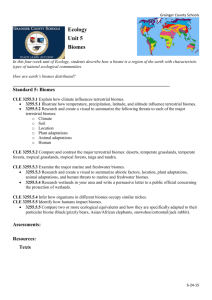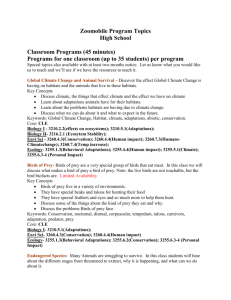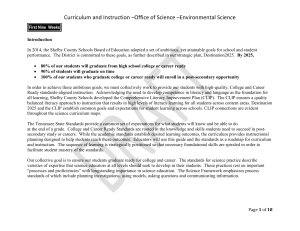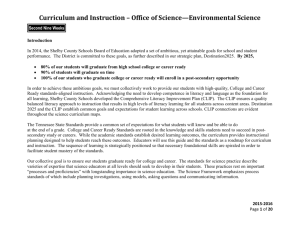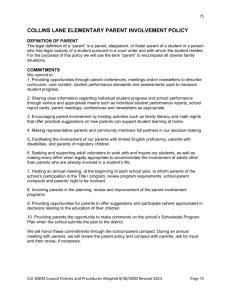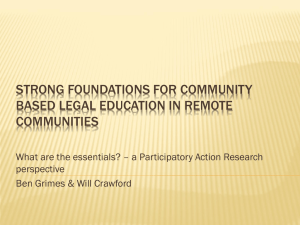File
advertisement
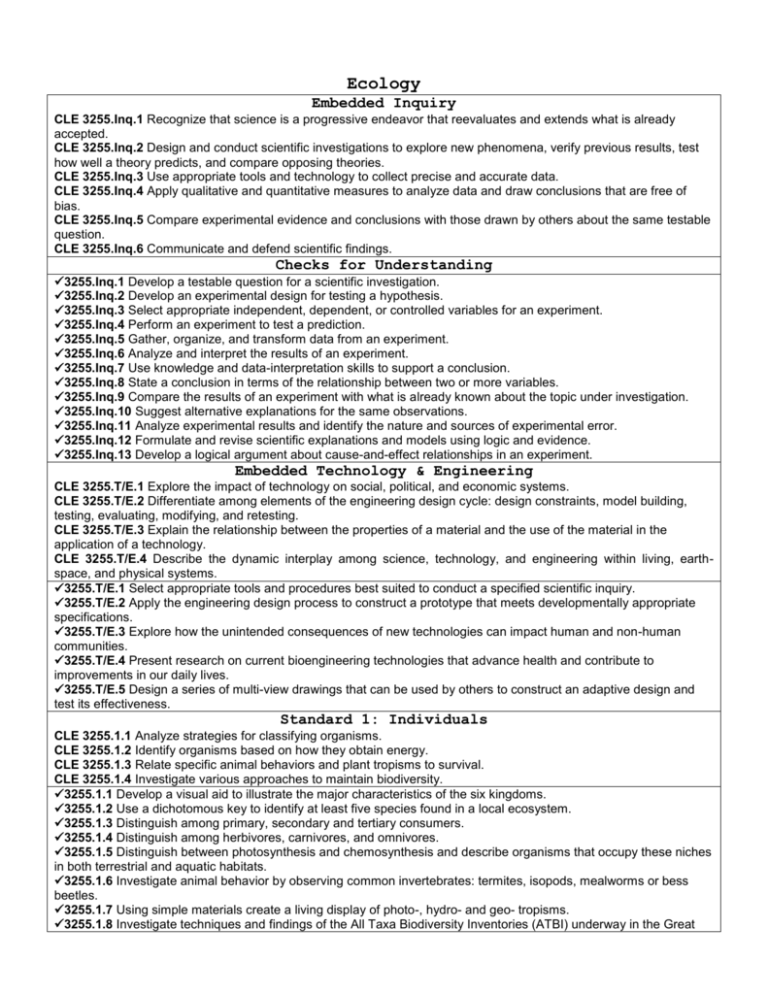
Ecology Embedded Inquiry CLE 3255.Inq.1 Recognize that science is a progressive endeavor that reevaluates and extends what is already accepted. CLE 3255.Inq.2 Design and conduct scientific investigations to explore new phenomena, verify previous results, test how well a theory predicts, and compare opposing theories. CLE 3255.Inq.3 Use appropriate tools and technology to collect precise and accurate data. CLE 3255.Inq.4 Apply qualitative and quantitative measures to analyze data and draw conclusions that are free of bias. CLE 3255.Inq.5 Compare experimental evidence and conclusions with those drawn by others about the same testable question. CLE 3255.Inq.6 Communicate and defend scientific findings. Checks for Understanding 3255.Inq.1 Develop a testable question for a scientific investigation. 3255.Inq.2 Develop an experimental design for testing a hypothesis. 3255.Inq.3 Select appropriate independent, dependent, or controlled variables for an experiment. 3255.Inq.4 Perform an experiment to test a prediction. 3255.Inq.5 Gather, organize, and transform data from an experiment. 3255.Inq.6 Analyze and interpret the results of an experiment. 3255.Inq.7 Use knowledge and data-interpretation skills to support a conclusion. 3255.Inq.8 State a conclusion in terms of the relationship between two or more variables. 3255.Inq.9 Compare the results of an experiment with what is already known about the topic under investigation. 3255.Inq.10 Suggest alternative explanations for the same observations. 3255.Inq.11 Analyze experimental results and identify the nature and sources of experimental error. 3255.Inq.12 Formulate and revise scientific explanations and models using logic and evidence. 3255.Inq.13 Develop a logical argument about cause-and-effect relationships in an experiment. Embedded Technology & Engineering CLE 3255.T/E.1 Explore the impact of technology on social, political, and economic systems. CLE 3255.T/E.2 Differentiate among elements of the engineering design cycle: design constraints, model building, testing, evaluating, modifying, and retesting. CLE 3255.T/E.3 Explain the relationship between the properties of a material and the use of the material in the application of a technology. CLE 3255.T/E.4 Describe the dynamic interplay among science, technology, and engineering within living, earthspace, and physical systems. 3255.T/E.1 Select appropriate tools and procedures best suited to conduct a specified scientific inquiry. 3255.T/E.2 Apply the engineering design process to construct a prototype that meets developmentally appropriate specifications. 3255.T/E.3 Explore how the unintended consequences of new technologies can impact human and non-human communities. 3255.T/E.4 Present research on current bioengineering technologies that advance health and contribute to improvements in our daily lives. 3255.T/E.5 Design a series of multi-view drawings that can be used by others to construct an adaptive design and test its effectiveness. Standard 1: Individuals CLE 3255.1.1 Analyze strategies for classifying organisms. CLE 3255.1.2 Identify organisms based on how they obtain energy. CLE 3255.1.3 Relate specific animal behaviors and plant tropisms to survival. CLE 3255.1.4 Investigate various approaches to maintain biodiversity. 3255.1.1 Develop a visual aid to illustrate the major characteristics of the six kingdoms. 3255.1.2 Use a dichotomous key to identify at least five species found in a local ecosystem. 3255.1.3 Distinguish among primary, secondary and tertiary consumers. 3255.1.4 Distinguish among herbivores, carnivores, and omnivores. 3255.1.5 Distinguish between photosynthesis and chemosynthesis and describe organisms that occupy these niches in both terrestrial and aquatic habitats. 3255.1.6 Investigate animal behavior by observing common invertebrates: termites, isopods, mealworms or bess beetles. 3255.1.7 Using simple materials create a living display of photo-, hydro- and geo- tropisms. 3255.1.8 Investigate techniques and findings of the All Taxa Biodiversity Inventories (ATBI) underway in the Great Smoky Mountains National Park and Tennessee State Parks. 3255.1.9 Explore careers in conservation biology and bioinformatics. Standard 2: Populations CLE 3255.2.1 Cite examples of populations limited by natural factors, humans or both. CLE 3255.2.2 Explain population growth patterns and rates. CLE 3255.2.3 Summarize how natural selection influences a population over time. 3255.2.1 Define population and describe several examples of populations in different ecosystems. 3255.2.2 Identify distribution patterns (random, uniform, clumped with groups random) and populations that exhibit each of these patterns. 3255.2.3 Using a population of yeast, duckweed or other suitable species, design and conduct an experiment to evaluate population growth and carrying capacity. 3255.2.4 Categorize limiting factors as density dependent or density independent, human influenced or non-human influenced, and biotic or abiotic when given scenarios. 3255.2.5 Evaluate populations based on age structure, distribution, and density. 3255.2.6 Draw and/or label population growth curves representing exponential growth, logistic growth and carrying capacity. 3255.2.7 Illustrate the type of survivorship curves created by r-strategists and K-strategists. 3255.2.8 Research case studies (Tasmanian sheep, St. Matthew’s Island reindeer, Isle Royale) to illustrate the consequences of logistic and exponential growth. 3255.2.9 Compare case studies of evolution such as Galapagos finches, peppered moths, and salamanders in the Smoky Mountains. Standard 3: Communities CLE 3255.3.1 Explain ecological niches within various habitats. CLE 3255.3.2 Relate species interactions such as competition, predation and symbiosis to coevolution. CLE 3255.3.3 Apply the first and second laws of thermodynamics to explain the flow of energy through a food chain or web. CLE 3255.3.4 Analyze how biomass is related to trophic levels. 3255.3.1 Describe the difference between a fundamental niche and a realized niche. 3255.3.2 Create a chart to compare and contrast specialist and generalist species and describe environmental conditions that favor these two approaches. 3255.3.3 Distinguish among the following roles and cite Tennessee examples of each: native species, non-native species, invasive species, indicator species, “keystone” species. 3255.3.4 Discuss how competition and predation regulate population size. 3255.3.5 Summarize the principles of competitive exclusion and resource partitioning. 3255.3.6 Distinguish among the three forms of symbiotic relationships. 3255.3.7 Describe structural and behavioral adaptations for survival used by predators and prey. 3255.3.8 Explain energy pyramids and the “Rule of 10” as they relate to the first and second laws of thermodynamics. 3255.3.9 Create a food web characteristic of a Tennessee ecoregion composed of at least four trophic levels. Standard 4: Ecosystems CLE 3255.4.1Describe the flow of energy flow through an ecosystem. CLE 3255.4.2 Describe how matter cycles through various biogeochemical cycles. CLE 3255.4.3 Evaluate the process of succession. CLE 3255.4.4 Summarize the human impact on ecosystems. CLE 3255.4.5 Describe how biodiversity relates to stability of an ecosystem. 3255.4.1 Trace energy flow from the sun through living organisms. 3255.4.2 Illustrate each of the following biogeochemical cycles: water, carbon, nitrogen, and phosphorus. 3255.4.3 Distinguish between primary and secondary biological succession. 3255.4.4 Explore a local area and examine the abiotic and biotic factors relating to succession and ecosystem structure. 3255.4.5 Summarize how disturbance contributes to succession and ecosystem stability. 3255.4.6 Identify how nutrient availability affects terrestrial and aquatic ecosystems. 3255.4.7 Design an ecosystem in the classroom (terrarium, bottle biology, eco-column, etc.) for making observations, conducting experiments and long-term monitoring. 3255.4.8 Create a concept map relating the events that lead to the parachuting of cats on Borneo by the World Health Organization. Standard 5: Biomes CLE 3255.5.1 Explain how climate influences terrestrial biomes. CLE 3255.5.2 Compare and contrast the major terrestrial biomes: deserts, temperate grasslands, temperate forests, tropical grasslands, tropical forests, taiga and tundra. CLE 3255.5.3 Examine the major marine and freshwater biomes. CLE 3255.5.4 Infer how organisms in different biomes occupy similar niches. CLE 3255.5.5 Identify how humans impact biomes. 3255.5.1 Illustrate how temperature, precipitation, latitude, and altitude influence terrestrial biomes. 3255.5.2 Research and create a visual to summarize the climate, soil, location, plant adaptations, animal adaptations, and human threats to each of the major terrestrial biomes. 3255.5.3 Research and create a visual to summarize abiotic factors, location, plant adaptations, animal adaptations, and human threats to marine and freshwater biomes. 3255.5.4 Research wetlands in your area and write a persuasive letter to a public official concerning the protection of wetlands. 3255.5.5 Compare two or more ecological equivalents and how they are specifically adapted to their particular biome (black/grizzly bears, Asian/African elephants, snowshoe/cottontail/jack rabbit). Standard 6: Humans and Sustainability CLE 3255.6.1 Investigate the role of public lands in sustaining biodiversity. CLE 3255.6.2 Examine state, national, and international efforts to sustain native species and ecosystems. CLE 3255.6.3 Evaluate the impact of personal actions on the environment. CLE 3255.6.4 Identify and explain choices you can make to lessen your impact on the environment. 3255.6.1 Differentiate the purposes of State and National Parks, Wildlife Refuges, and Forests. 3255.6.2 Design a vacation brochure, poster, slide show presentation or commercial advertisement that extols the virtues of a given area (e.g., state or national parks/forests) and ecotourism opportunities that may be found there. 3255.6.3 Research and paraphrase local, national, and international environmental legislation enacted to sustain biodiversity (e.g., The Lacy Act, Endangered Species Act, National Marine Fisheries Act, TWRA Hunting and Fishing Regulations, CITES). 3255.6.4 Develop a timeline that illustrates major local, national and international environmental legislation enacted to sustain biodiversity. 3255.6.5 Find out what watershed your school is located in and how wastewater, municipal solid, and hazardous wastes are handled. 3255.6.6 Research issues surrounding the adoption of environmentally and socially responsible behaviors (e.g., proper waste disposal, using fuel efficient transportation, planting native species, purchasing locally grown food, reducing/eliminating dependence on ‘one use’ products). 3255.6.7 Create a list of the “Five Biggest Threats to the Global Environment.”
